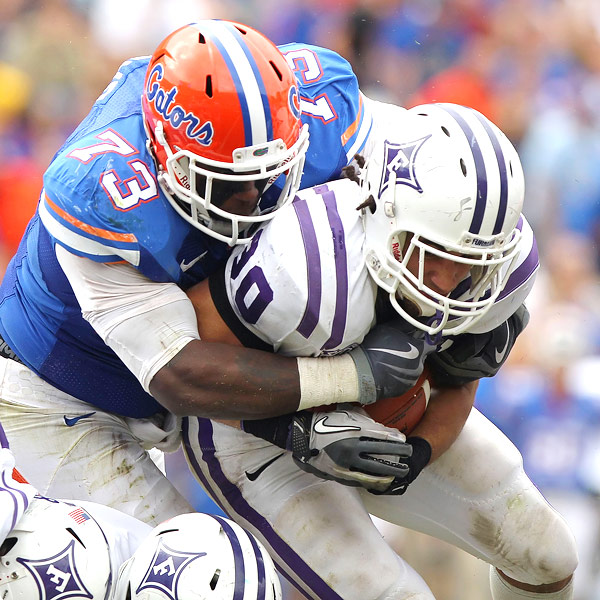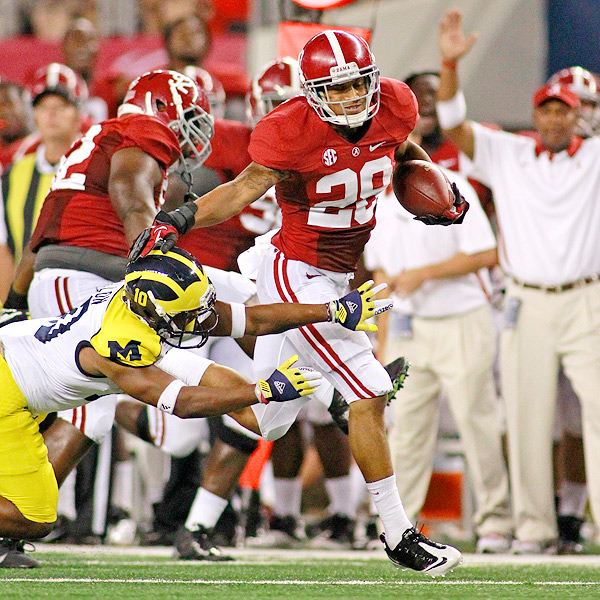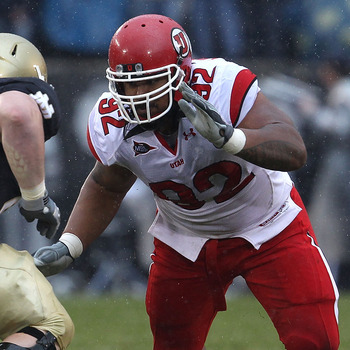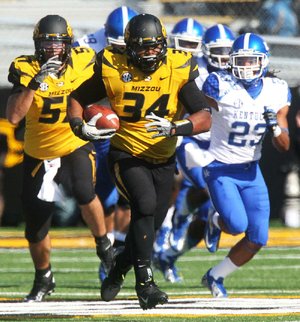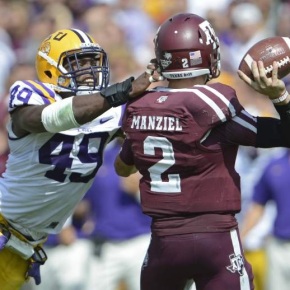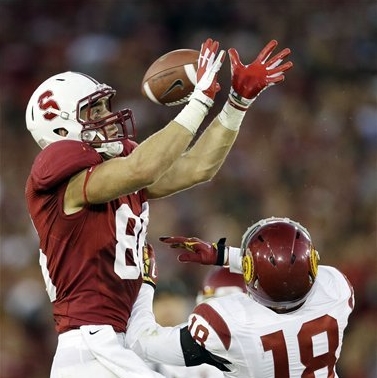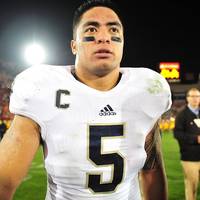
Knowing when to pounce and when to walk away is part of what makes the Seahawks' front office so effective
Note: Be sure to check out Rob’s article on Andy Reid below if you haven’t seen it already. Rob tends to post articles in the early afternoons, while I tend to post them in the dead of night. Often times we might bury each other’s work, so be sure to always scroll down and check. I’ve noticed that comment activity seems to be much higher on articles that top the page. We’d like to churn out content rapidly but one of the downsides is a shorter window for exposure and comment activity. Rest assured that if you comment in a lower article we always try to read through and answer your questions. So please don’t hesitate. We generally check the comments for a day or two, sometimes more if it’s highly active.
Darrelle Revis was a Hall of Fame caliber player before his ACL. Will he bounce back? Will he leave after one season and be an expensive rental? There are a lot of scenarios where dealing for Revis doesn’t make much sense. I think it’s a reason why the market for Revis at least appears to be cooling down a bit.
So that begs the question: at what point does the price make sense for Revis and the risk that comes with him? The Seahawks didn’t think that Matt Flynn made sense for them last offseason, primarily because they expected him to get Kevin Kolb money. When it became apparent this was not the case, Seattle’s interest was ignited and they ultimately pulled the trigger after viewing Flynn’s developing contract situation as an opportunity. I’m not sure if Seattle is wild about paying two firsts for Revis, but if the cost comes down enough, I think Seattle will have interest. The question becomes: where would a deal begin to make sense?
First you have to determine how much Revis is actually worth. That leads me to a series of questions:
How will Revis play coming off an ACL injury?
A few years ago, the ACL injury probably would have killed Revis’ trade value almost completely, but in recent years there have been many cases of players returning to full strength after such an injury. Adrian Peterson, Jamaal Charles, Eric Berry, etc. Revis has speed to spare (4.38 forty) and that seems to be the common link between those who bounced back the best from the injury. You can’t rule out the impact completely, but it’s not insane to think that you’d get Revis type production from Revis in 2013. The injury does increase the risk though, and will certainly effect the Jets’ asking price.
How likely is Revis to be retained after 2013 and what might his market price be?
Revis can’t be franchised after next season and is seeking an insane amount of money in free agency. Whichever team trades for Revis will have zero leverage in contract talks and it’s considerably likely that Revis will hit open free agency next year. And if that happens, it’s anyone’s guess where he ends up. Overall, I’d say it’s likely that whichever franchise trades for Revis is getting a rental.
That said, don’t overlook the “upside” of actually landing Revis in a long term deal after 2013. Teams that make trades for rental types have generally enjoyed a bit of an inside track on getting the next contract. I think at least some of Revis’ high demands come from the fact that he plays for a lousy Jets team and probably wants out. If Seattle makes a deep playoff run (which I think is pretty likely) and Revis believes he is on the NFL’s best team, it’s going to make it harder to take that slightly better offer from the Jacksonville Jaguars or Cleveland Browns next march. Revis is already very rich, and I think the next contract is really more of an ego thing. If you make him the highest paid corner, that might be enough.
The highest paid corners in the NFL made around $11 million last season. Revis wants $16 million a year. Maybe after a very positive experience in 2013, he might sign back in the $12-$14 million range. FWIW, when you compare Revis to other high paid NFL players, I think he justifies that kind of salary pretty easily. He’s one of the most valuable non-QB players in the league. Or to look at it another way, is Revis worth as much as Zach Miller and Alan Branch combined? Because that’s what $12 to 14 million in salary looks like. Of course, you don’t want to lose essential players so we’re just talking dollars in expendable/luxury players.
It would be nice if we had a “wins over replacement” type stat in football as they do in baseball, then the calculation of Revis’ worth would be very easy. We don’t, but consider that this is a league where Brandon Flowers, Leon Hall, Chris Gamble, DeAngelo Hall, Nnamdi Asomugha, and an old Champ Bailey all made $8 to $11 million at the cornerback position last season. A league where good #2 corners like Brandon Carr get 5/50 contracts.
I genuinely feel that if you get Revis back on a 5/60 or 5/70 contract (which would make him the highest paid corner in the league by a good margin), you are getting a more than solid return on your investment. If he proves healthy and as good as ever.
How much is Revis worth purely as a rental?
If you deal for Revis, what is a reasonable price in the event he’s just a rental for one season? His cap hit is a reasonable $9 million in 2013. As expressed above, I think even $14 million is a fair price for a contributor of his magnitude. So his 2013 salary of $9 million is a plus, in my opinion.
Paying a 1st round pick in the event of a rental is far too much. I think a late 2nd rounder sounds about right though for a team that is front and center for the Superbowl discussion entering the 2013 season. To be clear, I think a late 2nd rounder is an overpay for one season of any player, but there is a higher chance to have Revis beyond 2013 if you trade for him and that added chance carries value.
I also think that one season of Revis carries a lot more value to a team like Seattle than it would to a middling team because it would make a hard team to beat that much tougher. Even if Revis leaves, would anyone complain about burning the #64 pick if the Revis trade helped us win a Superbowl? In a worst case scenario, Seattle fails to win it all, Revis walks, and the pick is lost. That’s not a good situation. So there’s risk to weigh. Even in that worst scenario, there is tangible value in having Revis for one season. Look at what major league baseball teams pay for star rentals at the trade deadline- for less than half a season. They pay through the nose. Sure, different sport, different value paradigms, but I think the upside of winning a championship or keeping Revis long term counterbalances the risk of having a 2nd round pick potentially burned.
How will Richard Sherman and Darrelle Revis coexist? Do they magnify each other’s value or diminish it?
It’s hard to tell how Revis and Sherman would coexist as teammates. I think they’d make up pretty quickly, as Sherman is really more of a joker than a jerk and Revis certainly didn’t seem to be holding any grudges during his interview with Sherman teammate Michael Robinson.
http://www.youtube.com/watch?annotation_id=annotation_95245&feature=iv&src_vid=yqx1zoUskB4&v=NKx-jj0H1RY
It would be a really interesting competition dynamic to be sure, with both players competing for interceptions and big plays. I have to wonder if that very reason might be why Seattle was “highly interested” in Revis at the dawn of the trade talks. You know our coach loves competition, and a Revis-Sherman competition would be among the most epic in the history of the sport.
Having Revis on the field means more passes than usual will target Sherman, and vice versa. I think it would probably be a good thing forcing quarterbacks to throw more passes in Sherman’s direction, as well as Revis’. The passer rating on passes targeting Sherman and Revis are absurdly low. Combine that with Brandon Browner and Walter Thurmond covering the number three and four options, and you are looking at a secondary for the ages.
So here is where I think a trade begins to make sense for Seattle
Seattle trades a conditional 2014 pick. If Revis gets re-signed and remains with the Seahawks beyond the 2013 season, the Jets receive our 2014 1st round pick. If Revis signs with another team in free agency, the Jets receive a 2014 2nd round pick instead. If Revis proves his worth and signs an extension to remain here, he is easily worth a 1st round pick and the money we pay him, especially since that 1st round pick will probably be a very late one.
And before anyone flips out of the mythical value of a 1st round pick, consider the options Seattle had in the late first back in 2011, 2008, 2006, 2005, and 2004. Those picks turned into James Carpenter, Lawrence Jackson, Kelly Jennings, Chris Spencer, and Marcus Tubbs. You look at the late 1st round most years and it’s not nearly as good as you might imagine. It’s hardly a lock to get a star. Although I do love the late 1st this year, but that’s beside the point and trust me, this year is pretty uncommon in it’s depth. Anyway, he justifies that cost if he’s extended. This is Darrelle Revis we’re talking about, not Deion Branch.
And while I’m sure people are sick of hearing this, it’s possible that the Jets could have a degree of interest in Matt Flynn as competition for Mark Sanchez and that could have a minor impact on the trade details as well.
Maybe the Jets get a better offer elsewhere. I am not saying that we must trade for Revis at all costs. But I think if an offer like this is possible, at this type of risk/reward, the balance of the deal becomes one worth making.







